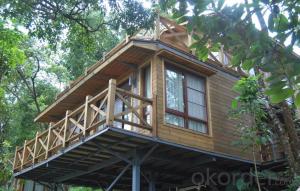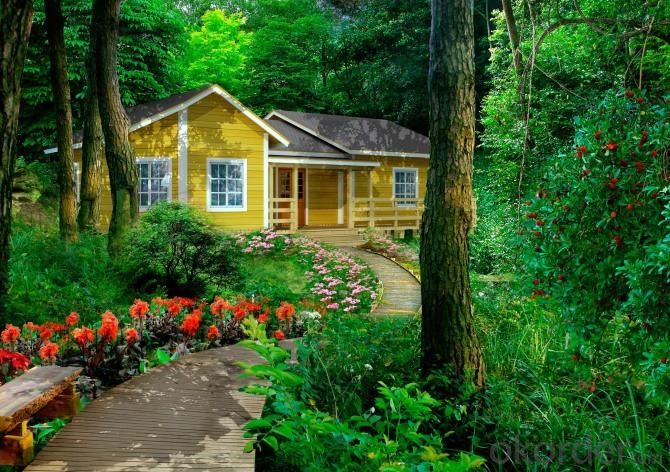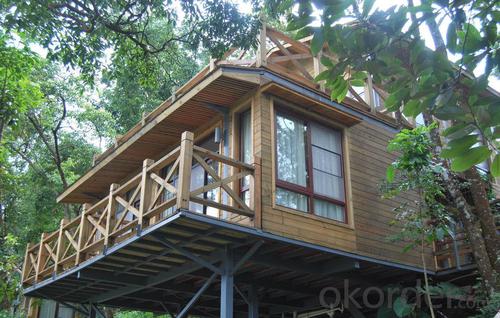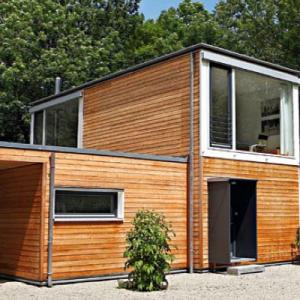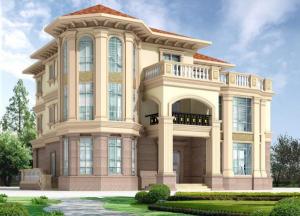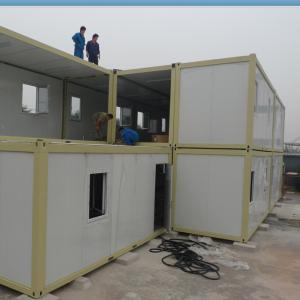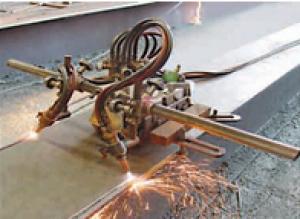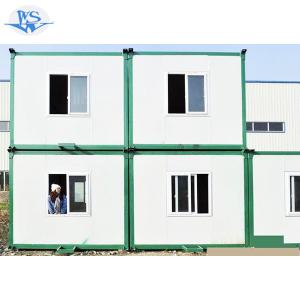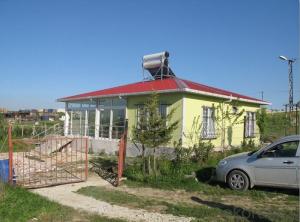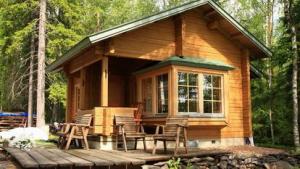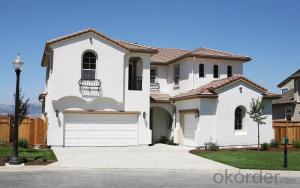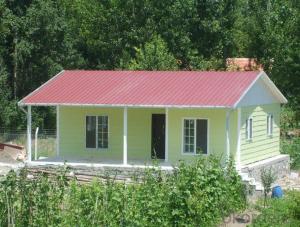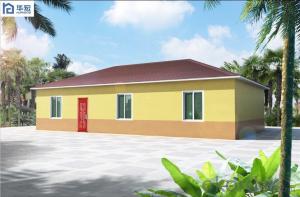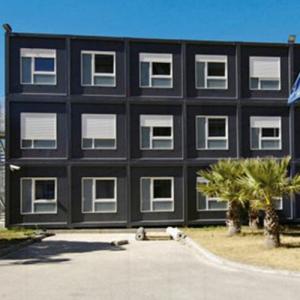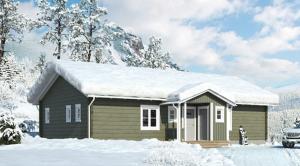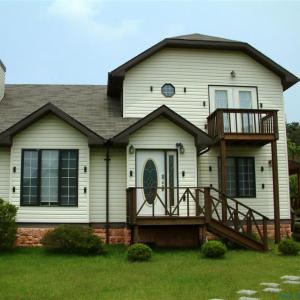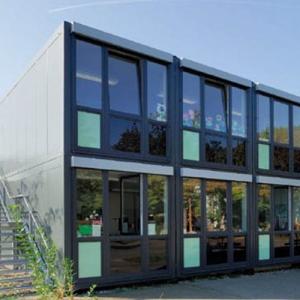Wooden House Made in China with Good Quality
- Loading Port:
- Shanghai
- Payment Terms:
- TT OR LC
- Min Order Qty:
- 1 m²
- Supply Capability:
- 1000 m²/month
OKorder Service Pledge
OKorder Financial Service
You Might Also Like
Wooden House Made in China with Good Quality
Simple and founctional family living house
Size:1420(L)cm x 790(W)cm x 418.5/293cm
Materail:SPF improt form Canada
Thickness of the wal:7.3 cm,thickness of the floor:2.3cm,thickness of the roof:1.7cm
Pattern:single -floor with three bedrooms + one living room + one dinning room +one kitchen +two bathrooms+one terrace
1,It's a nature and comfortable home
2,wooden house with exllent design.
3,economic, enviromental protect.
4,professional manufacture.
5,nature happiness
6,various styles
7,fire prevention
8,vibration resistance
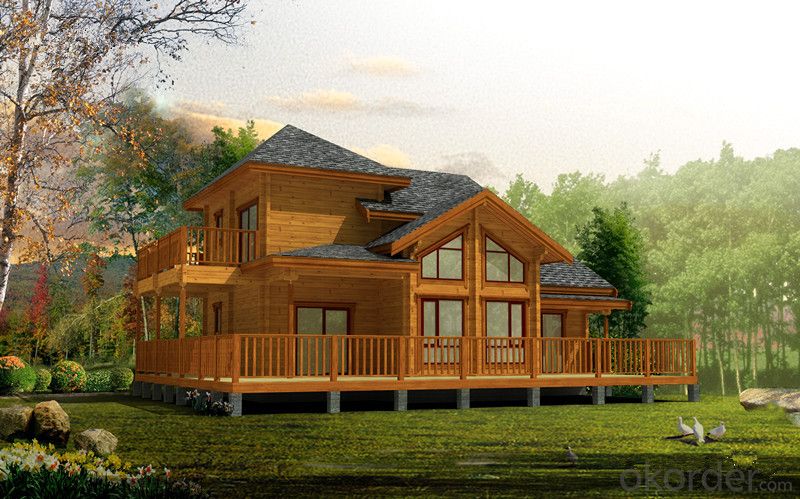

- Q: Can container houses be designed to have a loft or mezzanine level?
- Container houses have the ability to be designed with a loft or mezzanine level. The flexible floor plans of these modular constructions easily allow for the incorporation of multiple levels. A loft or mezzanine level can serve various purposes, such as providing additional living space, creating separate areas for different functions, or functioning as a sleeping area. The vertical space in container houses can be effectively utilized, maximizing the available square footage and offering a unique and efficient living experience. Furthermore, the inclusion of a loft or mezzanine level can enhance the industrial aesthetic of container houses, resulting in visually appealing interior designs. In conclusion, container houses are highly adaptable and can be customized to meet different needs and preferences, including the addition of loft or mezzanine levels.
- Q: Are container houses more affordable than traditional houses?
- Yes, container houses are generally more affordable than traditional houses. There are several factors that contribute to their affordability. Firstly, the cost of purchasing and converting shipping containers into livable spaces is significantly lower compared to the construction of a traditional house. Containers can be bought at a fraction of the price of building materials needed for a conventional house. Additionally, container houses require less labor and time to construct, resulting in reduced construction costs. As containers are pre-fabricated structures, they can be quickly assembled on-site, saving both time and money compared to the lengthy construction process of a traditional house. Furthermore, container houses are known for their energy efficiency, which can significantly reduce long-term costs. Containers are built with sturdy materials that provide excellent insulation, resulting in lower heating and cooling expenses. Moreover, container houses are highly flexible and customizable, allowing homeowners to choose the size, layout, and design that suits their needs and budget. This customization aspect allows for cost control and the ability to adapt the house to individual preferences. However, it is important to note that the final cost of a container house can vary depending on various factors such as location, design complexity, additional features, and the level of customization desired. Nevertheless, in most cases, container houses offer a more affordable alternative to traditional houses while still providing a comfortable and functional living space.
- Q: Can container houses have multiple stories?
- Yes, container houses can have multiple stories.
- Q: How do container houses compare to traditional houses in terms of durability?
- Durability sets container houses apart from traditional houses. Typically, traditional houses are constructed using materials like bricks, concrete, and wood, known for their ability to withstand various weather conditions and endure for decades. Conversely, container houses are built using repurposed shipping containers primarily intended for transporting goods, rather than providing long-term accommodation. Although container houses are often fortified with additional structural elements during conversion, they may still be more vulnerable to wear and tear compared to traditional houses. Factors such as corrosion, rusting, and damage to the container's original structure can potentially compromise the overall durability of a container house. Nevertheless, it is crucial to acknowledge that durability can vary depending on the construction quality and materials used in both traditional houses and container houses. For instance, a well-designed and properly constructed container house can offer comparable durability to a traditional house, especially when built with high-quality materials and subject to regular maintenance. Additionally, container houses possess the advantage of being pest-resistant, owing to their steel structure. This attribute contributes to their longevity in contrast to traditional houses, which may necessitate regular pest control measures. To conclude, while traditional houses boast a proven track record of durability, container houses can also provide a resilient living space if constructed with high-quality materials and given proper maintenance. Ultimately, the specific design, construction, and maintenance approaches employed in each case determine the level of durability offered.
- Q: Are container houses suitable for recreational vehicle parks?
- Yes, container houses can be suitable for recreational vehicle parks. They offer a unique and modern alternative to traditional RVs, providing a more permanent and durable structure for long-term stays. Container houses can be customized and designed to include all the necessary amenities for comfortable living, making them an attractive option for those seeking a different experience in a recreational vehicle park.
- Q: Can container houses be used for temporary housing solutions?
- Yes, container houses can be used for temporary housing solutions. They are portable, cost-effective, and can be easily transported and installed in various locations. Container houses provide a quick and convenient solution for temporary housing needs such as disaster relief efforts, construction projects, or temporary accommodation during events or festivals.
- Q: Can container houses be designed with a home library or study area?
- Yes, container houses can definitely be designed with a home library or study area. The modular nature of container houses allows for flexible interior configurations, making it possible to incorporate dedicated spaces for reading or studying. With proper planning and design, container houses can offer a comfortable and functional environment for bibliophiles and learners alike.
- Q: Are container houses suitable for individuals who value sustainability?
- Yes, container houses are suitable for individuals who value sustainability. These houses are made from repurposed shipping containers, which helps reduce waste and promotes recycling. By using existing materials, container houses help minimize the environmental impact of new construction. Additionally, the construction process for container houses typically requires less energy and resources compared to traditional housing, making them more sustainable. Furthermore, container houses can be designed to incorporate eco-friendly features such as solar panels, rainwater harvesting systems, and green roofs, further enhancing their sustainability. Overall, container houses provide an opportunity for individuals to live in a sustainable and environmentally-conscious manner.
- Q: Do container houses have plumbing and bathroom facilities?
- Yes, container houses can have plumbing and bathroom facilities. While shipping containers are typically not designed with plumbing or bathroom facilities, they can be easily modified to include these amenities. With proper planning and construction, container houses can have fully functional plumbing systems that include toilets, sinks, showers, and even hot water heaters. Many container house designs incorporate these features, allowing them to be used as comfortable and livable homes. Additionally, various off-grid and sustainable options are available for water supply and waste management in container houses, making them adaptable to different locations and environmental conditions.
- Q: Can container houses be designed with a home gym?
- Yes, container houses can definitely be designed with a home gym. Container houses are highly customizable and can be transformed into any type of living space, including a home gym. The open and flexible layout of container houses allows for the inclusion of various amenities, such as exercise equipment, weights, and even space for yoga or aerobics. Additionally, containers can be modified to have large windows or skylights, providing natural lighting and a spacious feel to the home gym. With proper planning and design, container houses can be tailored to suit individual fitness needs and preferences, creating a functional and convenient workout space within the confines of a container.
Send your message to us
Wooden House Made in China with Good Quality
- Loading Port:
- Shanghai
- Payment Terms:
- TT OR LC
- Min Order Qty:
- 1 m²
- Supply Capability:
- 1000 m²/month
OKorder Service Pledge
OKorder Financial Service
Similar products
Hot products
Hot Searches

